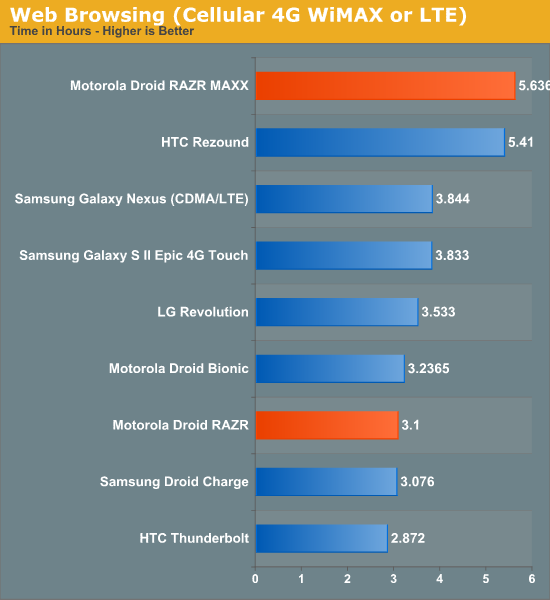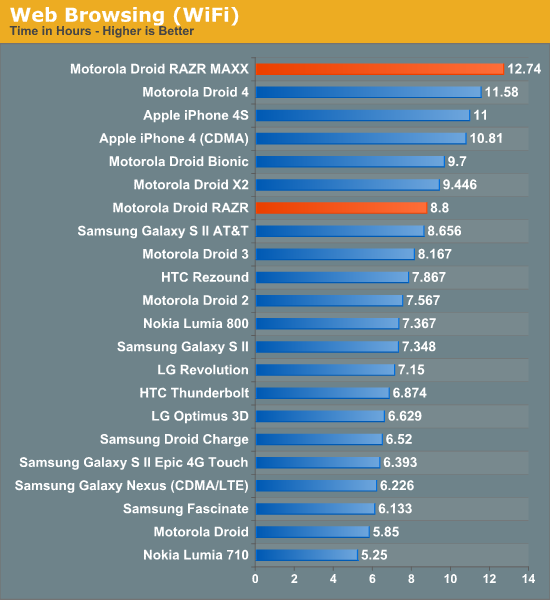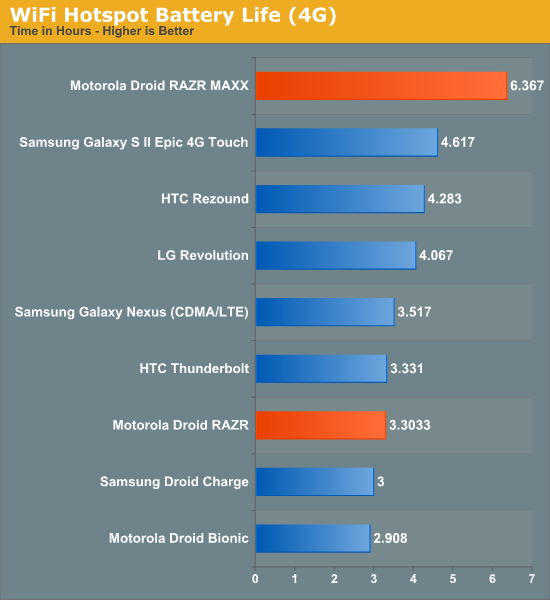Motorola Droid RAZR MAXX Review - 1.8x The Battery
by Brian Klug on February 14, 2012 2:01 PM EST- Posted in
- Smartphones
- Motorola
- Android
- Mobile
- motorola droid RAZR
- RAZR MAXX
- RAZR
Battery Life
Obviously the most important thing with this kind of upgrade is seeing just what kind of use time you can get out of a device with a relatively gargantuan 12.5 Whr battery, and for this we turned to our battery life testing suite. I investigated the Bionic’s extended battery back in its own review, and these increases in battery size almost always reflect (unsurprisingly) almost a perfect linear scaling.
When I started this review, the RAZR MAXX was running the original software release just before the 6.12.173 update which we briefly discussed in a pipeline post. This update adds connected discontinuous reception (cDRX) support to the RAZR MAXX’s ‘Wrigley’ LTE baseband, which improves battery life. That said I’m told only markets with Ericsson as the supplier have been updated, and I’m in an Alcatel-Lucent Verizon area. The point is that battery life really can only get better from the numbers below, and if you’re lucky enough to be in one of those markets, you’ll enjoy the benefits with the latest update. In addition, I also discovered that our RAZR review unit was running a weird build of software, 6.11.777, which I’ve since managed to get running 6.12.173 just like the MAXX, though most of these tests reflect the 6.11.777 numbers we initially obtained. If you’ve been watching bench as I’ve added numbers, this is why things sometimes change around until the review posts as I run and re-run tests. While finishing this review I’ve obtained an HTC Rezound and Droid 4 which we’re working on reviewing as well - these battery life results are included in here where available as well.
Anyhow, onto the results. The tests haven’t changed since we’ve talked about them last, and first up is the call test which consists of a call placed between the phone under test and another line, with music played a both ends at medium volume to avoid saturation.

Unsurprisingly we see an almost perfect 1.8x scaling here and get very close to the expected 21 hours of battery life you’d expect. The RAZR MAXX lasts astoundingly long if you’re interested in just voice calls, and Motorola continues to dominate the CDMA2000 1x voice tests. On 4G LTE handsets this is with the phone left in “CDMA/LTE” mode, though the LTE baseband is in RRC_IDLE state and consuming almost no power, while the MDM6600 handles the 1x voice call. As an aside, we’re almost getting to the point where voice battery life is so long that running this test is almost unweildy.
Next up are the web browsing tests, on 3G EVDO, 4G LTE, and WiFi. Here we load through a couple dozen pages with the display set to exactly 200 nits until the phone dies. We’re going to update this pretty soon with some more cache-busting features, but for now it does demonstrate that nice scaling for the most part.



In both the 3G and 4G tests, we see very close to the expected scaling, and the RAZR MAXX easily captures the top spot among Android phones. The only phone close to the RAZR MAXX at basically any point is the HTC Rezound in this test, which surprised me with its LTE battery life. On EVDO the RAZR MAXX is pretty much top dog among the Android crowd, and also good enough to place among the iPhone 4 and 4S. Only in the WiFi web browsing test does the MAXX slip just short of the expected 1.8x scaling, but still posts an impressive result.
Finally we’ve got our hotspot battery life tests, which consist of four tabs of our page tests and a 128 kbps MP3 streaming radio session being loaded on one client laptop and a WPA2 PSK. I had some issues with the hotspot stability on the original RAZR software, and had to resort to running that initial test with WPA2 turned off. I’ve repeated these tests and now have better numbers.

The hotspot test is great since it’s the only place other than the call test where we can isolate out the display (which ends up being by far the dominant factor) and gauge power draw from the combination of SoC, cellular baseband, RF, and WLAN. Here you can see the RAZR MAXX performs as expected and pretty much blows away everything else - other devices like the Rezound might get better battery life with the display on from using LCD (as opposed to AMOLED), but you can’t get around having more watt-hours to draw from.
So what do all these tests translate to in real world day to day use? Well, like anything the answer depends on your workload. If you use the phone as a hotspot while playing GTA III, obviously you’re going to still kill the phone in a few hours. If you’re just using it to occasionally poll twitter, check email, and reply to a few text messages, battery life on the order of two days isn’t hard to imagine. It’s hard to assign a realistic number given just how varied everyone’s use patterns are.
| Charging Time Comparison | ||||||
| Motorola Droid RAZR | Motorola Droid RAZR MAXX | |||||
| Charge time from 0% to 100% | 3.083 hours | 4.217 hours | ||||
I also tested how long the RAZR MAXX takes to charge fully after being completely, absolutely bone dry empty. On the MAXX that comes to 4.217 hours using the Motorola supplied 750 mA charger, which isn’t bad at all. The MAXX battery capacity isn’t so large that you can’t charge it on a nightstand and expect it to be 100% in the morning. I also timed the normal RAZR which came to just over 3 hours. I expected the MAXX to take much longer to charge, but the reason is no doubt the fact that Li-Ion battery charge curves aren't linear at all.










45 Comments
View All Comments
jjj - Tuesday, February 14, 2012 - link
Thanks for the charging time test,was curious about that.As for more devices with large battery maybe we'll see more but it's not all about sealing the battery,Moto did a couple of other things like use a thinner screen and populate only 1 side of the PCB.Ofc the touch layers are about to get thinner and Gorilla 2 is also a bit thinner so in theory it is getting easier to fit a larger battery.Problem is that the industry thinks 1 day battery life is the sweetspot and the marketing guys like thinner much better.so chances are that we'll see 6mm phones or less soon but not many will race to include a large battery in a thicker package.There is a next step soon to make em even thinner but,i'll let the phone makers figure that out .
jontech - Tuesday, February 14, 2012 - link
I liked the feel of the RZR but the thickness at the top was simply poor design. Now with a more uniform feel I want to see itmutatio - Tuesday, February 14, 2012 - link
I know, right? I've been sick of the lopsided top end since the designs first came out. I find it a bit ironic that a non-iPhone device went with the built-in battery as that's one of the mantras the Apple haters immediately scream about. This phone sets a high bar for talk time, for sure, though I personally use my cellphone for mostly data related activities.pedro441 - Tuesday, February 14, 2012 - link
So if I'm not worried about computational advantages offered by the new processors and care strictly about battery life on LTE (and recognizing that predicting the future is hard...) which will better get me through the day?shabby - Tuesday, February 14, 2012 - link
My crystal ball says wait for the future to come and then decide.mcnabney - Wednesday, February 15, 2012 - link
At what time in the past 25 years has something bigger, faster, sleeker, smarter, or better NOT just been around the corner?There will be something even COOLER coming out after Krait. There always is. If you need a new device, unless you actually NEED what the next generation has, just buy the device that is best for you now.
pedro441 - Wednesday, February 15, 2012 - link
Yes, I take your point. I will submit, however, that the battery life of successive devices has not been subject to the rapid improvement that those other characteristics you mention have shown.nafhan - Thursday, February 16, 2012 - link
If you're not worried about compute advantages. Get this. I'd guess most phones built on 28nm CPU's will use the lower power draw to allow smaller cheaper batteries not two days of battery life (at least not at first).The Razor MAXX also the obvious advantage of being available NOW instead of some unspecified date in the future. :)
piroroadkill - Tuesday, February 14, 2012 - link
You packed in a massive battery whilst still letting the device remain thin.I sincerely hope every other manufacturer follows suit, fast.
michael2k - Tuesday, February 14, 2012 - link
In both the 3G and 4G tests, we see very close to the expected scaling, and the RAZR MAXX easily captures the top spot.Actually, in the 3G test we show the iPhone 4S has the top spot at 9.85H, so you either have a mistake in text or your graph is wrong.